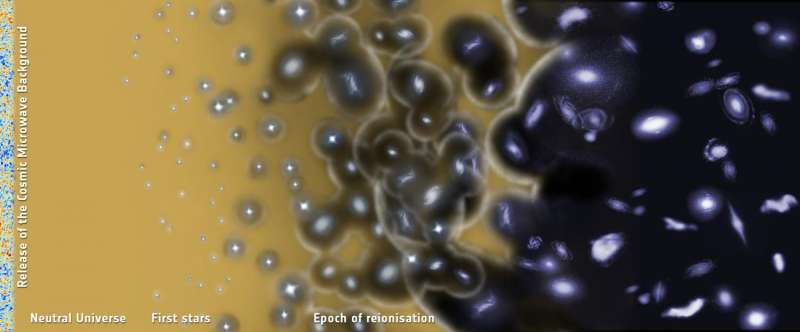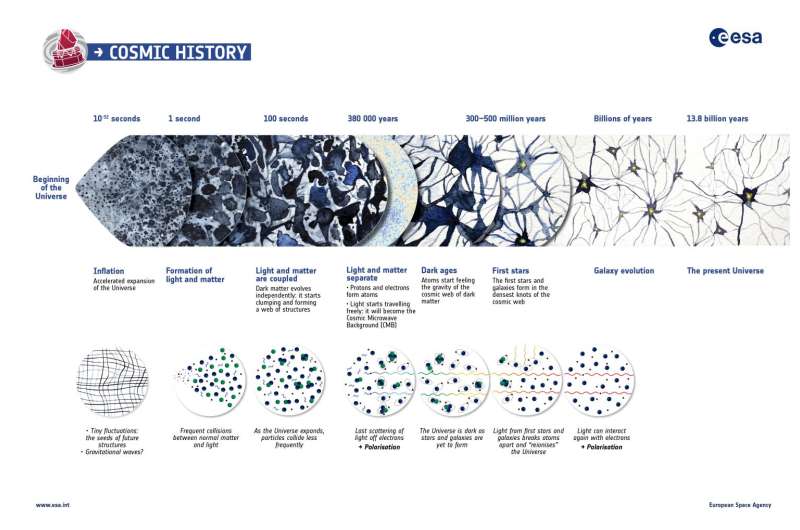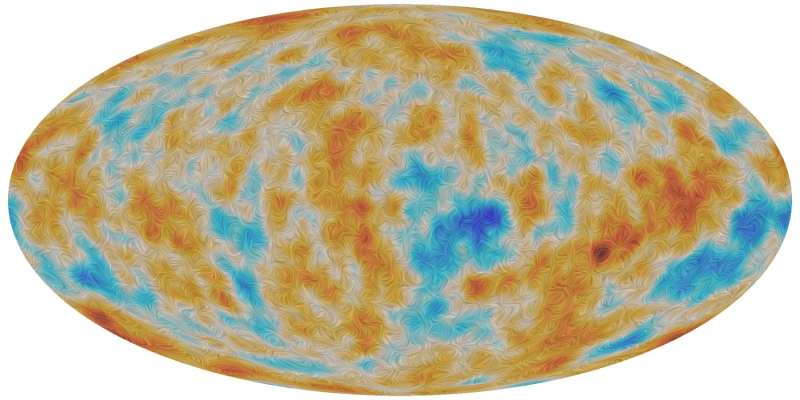Artist's impression of a portion in the timeline of the Universe, around the 'epoch of reionisation' – the process that ionised most of the material in the cosmos. The illustration begins from the release of the Cosmic Microwave Background, or CMB (on the left), the most ancient light in the history of the cosmos, dating back to 380 000 years after the Big Bang, and proceeds towards the right, with the formation of the first stars and galaxies in the Universe. Before the release of the CMB, the cosmos consisted of a hot, dense soup of particles. At that time, collisions between electrons and photons – the particles of light – were so frequent that light particles could not travel any significant distance before colliding with electrons. As the cosmos expanded, the Universe grew cooler and more rarefied and, after about 380 000 years, finally became 'transparent'. By then, particle collisions were extremely sporadic and photons could travel freely across the cosmos. The distribution of the CMB on the sky reveals tiny fluctuations that contain a wealth of information about the history, composition and geometry of the Universe. These fluctuations are shown in the vertical strip on the left, which is based on observations of the CMB from ESA's satellite Planck. The release of the CMB happened at the time when electrons and protons joined to form hydrogen atoms. This is the first moment in the history of the cosmos when matter was in an electrically neutral state (represented in yellow). After that, a few hundred million years passed before these atoms could assemble and eventually give rise to the Universe's first generation of stars (left of centre, in the illustration). As these first stars came to life, they filled their surroundings with light, which subsequently split neutral atoms apart, turning them back into their constituent particles: electrons and protons. This process, called cosmic reionisation, is shown at the centre of the illustration. A new analysis of data from Planck's High-Frequency Instrument (HFI) has demonstrated that reionisation started much later than any previous CMB data have suggested, and that it had half-reionised the Universe (right of centre in this illustration) by the time it was about 700 million years old. It did not take long until the end of this process: observations of very distant galaxies hosting supermassive black holes indicate that the Universe had been completely reionised by the time it was about 900 million years old (on the right). The new study based on Planck data locates the formation of the first stars much later than previously thought on the cosmic timeline, suggesting that the first generation of galaxies are well within the observational reach of future astronomical facilities, and possibly even of some current ones. Credit: ESA – C. Carreau
ESA's Planck satellite has revealed that the first stars in the Universe started forming later than previous observations of the Cosmic Microwave Background indicated. This new analysis also shows that these stars were the only sources needed to account for reionising atoms in the cosmos, having completed half of this process when the Universe had reached an age of 700 million years.
With the multitude of stars and galaxies that populate the present Universe, it's hard to imagine how different our 13.8 billion year cosmos was when it was only a few seconds old. At that early phase, it was a hot, dense primordial soup of particles, mostly electrons, protons, neutrinos, and photons – the particles of light.
In such a dense environment the Universe appeared like an 'opaque' fog, as light particles could not travel any significant distance before colliding with electrons.
As the cosmos expanded, the Universe grew cooler and more rarefied and, after about 380 000 years, finally became 'transparent'. By then, particle collisions were extremely sporadic and photons could travel freely across the cosmos.
Today, telescopes like Planck can observe this fossil light across the entire sky as the Cosmic Microwave Background, or CMB. Its distribution on the sky reveals tiny fluctuations that contain a wealth of information about the history, composition and geometry of the Universe.
The release of the CMB happened at the time when electrons and protons joined to form hydrogen atoms. This is the first moment in the history of the cosmos when matter was in an electrically neutral state.
After that, a few hundred million years passed before these atoms could assemble and eventually give rise to the Universe's first generation of stars.
As these first stars came to life, they filled their surroundings with light, which subsequently split neutral atoms apart, turning them back into their constituent particles: electrons and protons. Scientists refer to this as the 'epoch of reionisation'. It did not take long for most material in the Universe to become completely ionised, and – except in a very few, isolated places – it has been like that ever since.
A summary of the almost 14 billion year history of the Universe, showing in particular the events that contributed to the Cosmic Microwave Background, or CMB. The timeline in the upper part of the illustration shows an artistic view of the evolution of the cosmos on large scales. The processes depicted range from inflation, the brief era of accelerated expansion that the Universe underwent when it was a tiny fraction of a second old, to the release of the CMB, the oldest light in our Universe, imprinted on the sky when the cosmos was just 380 000 years old; and from the 'Dark Ages' to the birth of the first stars and galaxies, which reionised the Universe when it was a few hundred million years old, all the way to the present time. Tiny quantum fluctuations generated during the inflationary epoch are the seeds of future structure: the stars and galaxies of today. After the end of inflation, dark matter particles started to clump around these cosmic seeds, slowly building a cosmic web of structures. Later, after the release of the CMB, normal matter started to fall into these structures, eventually giving rise to stars and galaxies. The inserts below show a zoomed-in view on some of the microscopic processes taking place during cosmic history: from the tiny fluctuations generated during inflation, to the dense soup of light and particles that filled the early Universe; from the last scattering of light off electrons, which gave rise to the CMB and its polarisation, to the reionisation of the Universe, caused by the first stars and galaxies, which induced additional polarisation on the CMB. Credit: ESA
Observations of very distant galaxies hosting supermassive black holes indicate that the Universe had been completely reionised by the time it was about 900 million years old. The starting point of this process, however, is much harder to determine and has been a hotly debated topic in recent years.
"The CMB can tell us when the epoch of reionisation started and, in turn, when the first stars formed in the Universe," explains Jan Tauber, Planck project scientist at ESA.
To make this measurement, scientists exploit the fact that a fraction of the CMB is polarised: part of the light vibrates in a preferred direction. This results from CMB photons bouncing off electrons – something that happened very frequently in the primordial soup, before the CMB was released, and then again later, after reionisation, when light from the first stars brought free electrons back onto the cosmic stage.
"It is in the tiny fluctuations of the CMB polarisation that we can see the influence of the reionisation process and deduce when it began," adds Tauber.
A first estimate of the epoch of reionisation came in 2003 from NASA's Wilkinson Microwave Anisotropy Probe (WMAP), suggesting that this process might have started early in cosmic history, when the Universe was only a couple of hundred million years old. This result was problematic, because there is no evidence that any stars had formed by then, which would mean postulating the existence of other, exotic sources that could have caused the reionisation at that time.
This first estimate was soon to be corrected, as subsequent data from WMAP pushed the starting time to later epochs, indicating that the Universe had not been significantly reionised until at least some 450 million years into its history.
This eased, but did not completely solve the puzzle: although the earliest of the first stars have been observed to be present already when the Universe was 300 to 400 million years old, it remained unclear whether these stars were the main culprits for reionising fully the cosmos or whether additional, more exotic sources must have played a role too.
In 2015, the Planck Collaboration provided new data to tackle the problem, moving the reionisation epoch even later in cosmic history and revealing that this process was about half-way through when the Universe was around 550 million years old. The result was based on Planck's first all-sky maps of the CMB polarisation, obtained with its Low-Frequency Instrument (LFI).
A visualisation of the polarisation of the Cosmic Microwave Background, or CMB, as detected by ESA's Planck satellite over the entire sky. The CMB is a snapshot of the oldest light in our Universe, imprinted on the sky when the Universe was just 380 000 years old. It shows tiny temperature fluctuations that correspond to regions of slightly different densities, representing the seeds of all future structure: the stars and galaxies of today. A small fraction of the CMB is polarised – it vibrates in a preferred direction. This is a result of the last encounter of this light with electrons, just before starting its cosmic journey. For this reason, the polarisation of the CMB retains information about the distribution of matter in the early Universe, and its pattern on the sky follows that of the tiny fluctuations observed in the temperature of the CMB. In this image, the colour scale represents temperature differences in the CMB, while the texture indicates the direction of the polarised light. The patterns seen in the texture are characteristic of 'E-mode' polarisation, which is the dominant type for the CMB. For the sake of illustration, both data sets have been filtered to show mostly the signal detected on scales around 5° on the sky. However, fluctuations in both the CMB temperature and polarisation are present and were observed by Planck on much smaller angular scales, too. Credit: ESA and the Planck Collaboration
Now, a new analysis of data from Planck's other detector, the High-Frequency Instrument (HFI), which is more sensitive to this phenomenon than any other so far, shows that reionisation started even later – much later than any previous data have suggested.
"The highly sensitive measurements from HFI have clearly demonstrated that reionisation was a very quick process, starting fairly late in cosmic history and having half-reionised the Universe by the time it was about 700 million years old," says Jean-Loup Puget from Institut d'Astrophysique Spatiale in Orsay, France, principal investigator of Planck's HFI.
"These results are now helping us to model the beginning of the reionisation phase."
"We have also confirmed that no other agents are needed, besides the first stars, to reionise the Universe," adds Matthieu Tristram, a Planck Collaboration scientist at Laboratoire de l'Accélérateur Linéaire in Orsay, France.
The new study locates the formation of the first stars much later than previously thought on the cosmic timeline, suggesting that the first generation of galaxies are well within the observational reach of future astronomical facilities, and possibly even some current ones.
In fact, it is likely that some of the very first galaxies have already been detected with long exposures, such as the Hubble Ultra Deep Field observed with the NASA/ESA Hubble Space Telescope, and it will be easier than expected to catch many more with future observatories such as the NASA/ESA/CSA James Webb Space Telescope.
'Planck intermediate results. XLVII. Planck constraints on reionization history' and 'Planck intermediate results. XLVI. Reduction of large-scale systematic effects in HFI polarization maps and estimation of the reionization optical depth' by the Planck Collaboration are published in Astronomy and Astrophysics.
More information: Matthieu Tristram. Planck intermediate results. XLVII. Planck constraints on reionization history, Astronomy & Astrophysics (2016). DOI: 10.1051/0004-6361/201628897
Planck Collaboration. Planck intermediate results. XLVI. Reduction of large-scale systematic effects in HFI polarization maps and estimation of the reionization optical depth, Astronomy & Astrophysics (2016). DOI: 10.1051/0004-6361/201628890
Journal information: Astronomy & Astrophysics
Provided by European Space Agency


























